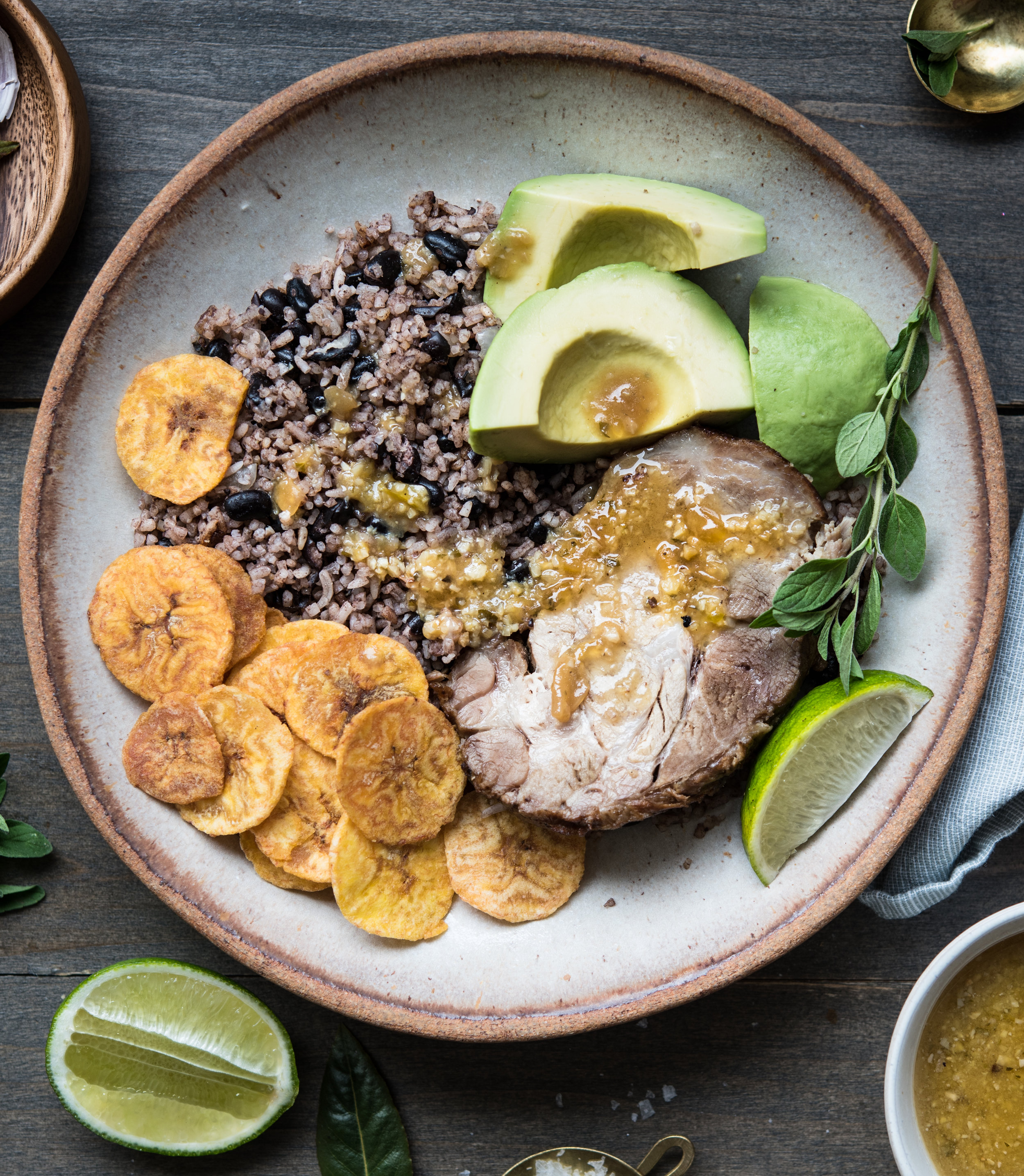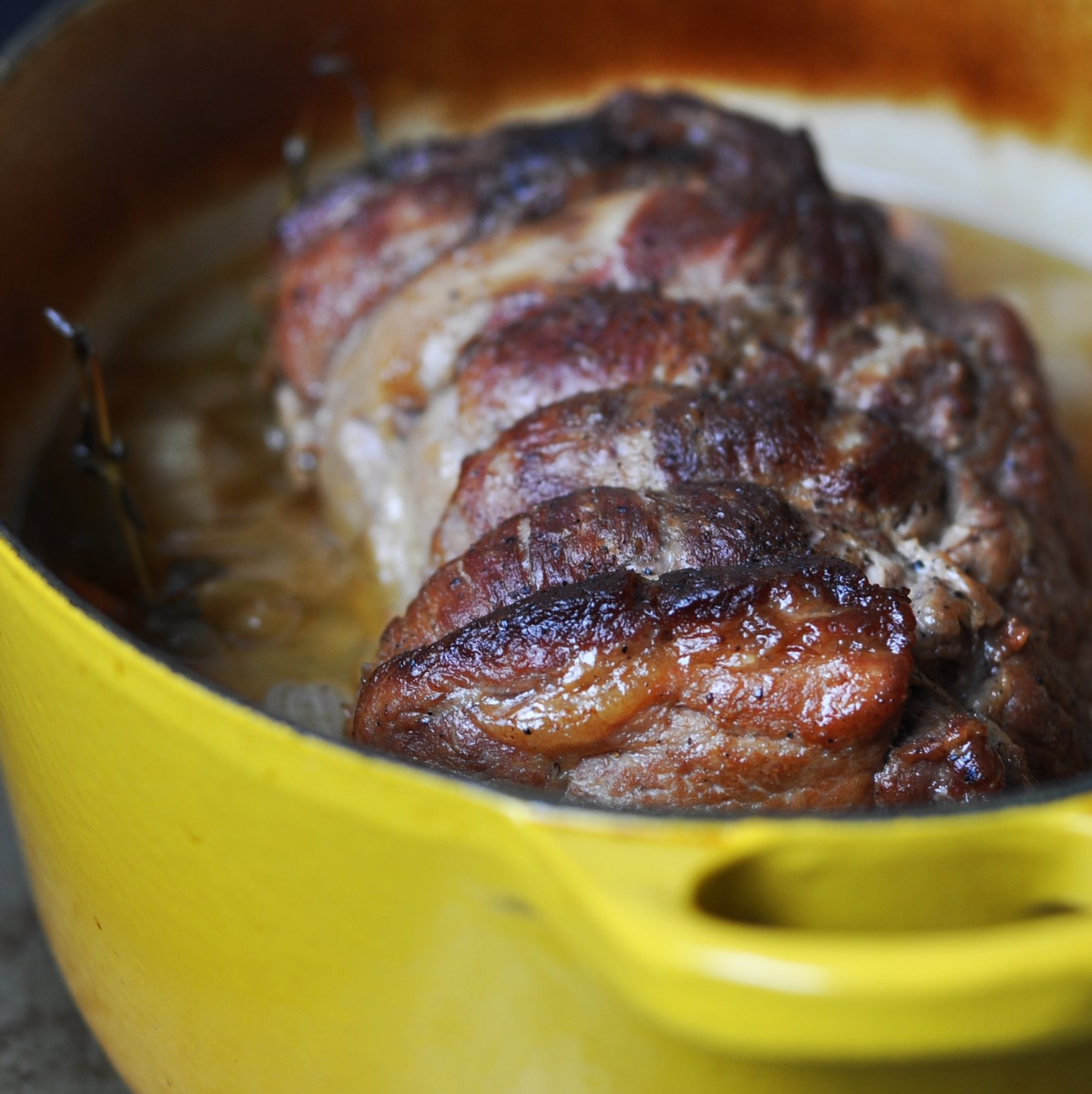Miso Gochujang Braised Pork Roast
I have been looking forward to sharing this recipe for my MISO GOCHUJANG PORK ROAST for months. It is an absolute gold star recipe. You would never know from miso's intense brininess and gochujang's savory spicy pungency, that using both of these together in this recipe results in a braised pork roast that is deeply flavorful, yet wonderfully mellow. There's a bit of a cultural mash-up, wherein the miso hails from Japan and the gochujang from Korea. They are both fermented condiments involving soybeans and rice and yet they are definitely different, but works in harmony in the recipe. The saké in the recipe imparts a subtle floral note that adds another level of nuance.
My recipe uses a 4-lb pork roast which would technically feed 8 adults (assuming 1/2-lb each). But don't hesitate for a second to make the full recipe even if you have a smaller crowd or smaller family to feed like me. I always want leftovers. There are so many ways to stretch the leftover pork into another meal or two or even three! In fact, I have posted some ideas before to use leftovers from a more "classic" beer-braised pork roast recipe from last year, such as this 'Pulled Pork & Brussels Sprouts Fried Rice' or 'Pappardelle with Pulled Pork & Wilted Spinach'.
As for the pork itself, do invest in the best quality you can find and afford, even if it means eating it less often and/or less of it at any one meal (and eating more veggies and sides). For a pork roast, I first ask my butcher if they have a 'capicola' (which is usually less lean than their 'standard' pork shoulder) or a Berkshire pork shoulder (the Berkshire breed is renowned for it's more tender and fatty meat). Even if they don't have either and I go for the regular pork shoulder, I ask to see a few pieces and select one based on the visible marbling. More marbling (of fat and collagen) means more tender and juicy roast! You're paying your good dollars for it, so it may as well be the best one available, don't you think? If you do have access to a Berkshire pork roast, do go for it. Admittedly I cringe at the relatively higher cost but since I make one roast stretch into at least two if not three meals, I don't feel too guilty about it.
If you're looking to switch up your been-there-done-that Sunday roast, then make this one instead. We love it!
p.s. Stay tuned for a follow-up post next week for another leftover pork roast meal idea. It's definitely outside the box. BE excited!!
Miso + Gochujang Braised Pork Roast
Recipe serves 7-8. (I often make this for our family of 4. Leftovers are easily reinvented into different meals! See head notes for suggestions.)
INGREDIENTS
4lb boneless pork shoulder (see head notes about choosing a pork roast)
3 leeks, white and light green parts only cut into 1" pieces, or substitute with 3 celery stalks or 3 white onions
4 medium carrots, peeled and cut into 1" large pieces
3 cloves garlic, peeled and smashed
1 tbsp gochujang
2 tbsp white miso paste
300ml bottle of saké (Japanese rice wine), or can substitute dry white wine
1 tbsp honey
1 tbsp tamari or light soy sauce (if gluten intolerance is not an issue)
2 C chicken broth, homemade or quality store-bought low sodium
Water to top up braising liquid, as needed
Kosher salt & pepper
METHOD
Place a large, heavy-bottom Dutch oven on the stove and heat it over medium-high heat. Meanwhile, season the entire pork liberally with salt. [ Note re: salt: always use your discretion on the amount of salt to use. People’s taste for salt range widely, the salinity of different types of salts (kosher, table, sea salt, etc) range widely, and even kosher salt can vary significantly from brand to brand (Diamond Crystal brand being the least salty. Additionally, lessen the amount of salt if you are using salted versus unsalted broth in the recipe]. I use Diamond Crystal kosher salt and use about 1 tsp per each pound of pork roast, in other words 4 tsp of Diamond Crystal kosher salt for a 4-lb roast. This may seem like a lot, but imagine you are seasoning the entire thickness of the roast too, not just its surface. Not to mention, some of that seasoning is for the braising liquid. If using a different brand of kosher salt, I suggest using half as much or 2 tsp for 4lb pork roast as a starting point.
Add a little bit of high-heat oil and immediately put in pork shoulder, fat cap side down if there is a fat side. The fat will render into oil and continue to brown the pork on all sides. Add oil if pork roast is not fatty. Sear all sides including ends until nicely golden brown all over. Set it aside.
If there is a lot of oil rendered into the pot, use a pair of kitchen tongs holding some paper towels to mop up excess oil – only a few tablespoons of fat is needed for the next step. Add leeks, carrots and smashed garlic cloves in the oil. Season lightly with salt and pepper. Sauté until veggies start to soften. Add gochujang and miso paste, stirring to break them down a bit and to heat through to develop flavor. Deglaze pot with saké. Simmer for a minute to dissipate the alcohol. Once the sharp alcohol smell has diffused, stir in honey and tamari (or soy sauce). Return pork roast to Dutch oven. Add chicken broth, and top up water as needed such that liquid is 3/4 way up the sides of the roast.
Bring to a boil. Cover and braise on the stove at a low simmer for about 1.5 hours or covered in a 325f oven for 2-2.5 hours, or whenever meat is tender. When roasting large pieces of meat like this, it's helpful to have a meat thermometer to take the guessing out of whether the meat is done or not. For pork roast, a thermometer stuck into the thickest part should read ~170f (it will cook further 10 degrees or so as it rests). This gets the roast to a tender stage but still firm enough to slice into ~3/4" thick pieces for serving - which is the way we like to enjoy it. Braise longer if you prefer it to be "fork tender" aka you can pull the meat apart with two forks, which is when the meat's internal temperature reaches ~180f (it will cook further 10 degrees or so as it rests). Once done, pull the roast out to rest on a cutting board, tented lightly with foil, for 20 minutes or so to allow the juices to reabsorb into the meat. This ensures juicy pork roast every time.
While the pork rests, check the liquid in your pot whether you want to thicken it or not. I typically whisk 1-2 tbsp of arrowroot powder (you may use cornstarch as well) for a thicker sauce. Simmer on very low on the stovetop for a minute, turn off heat, and keep warm on residual heat until ready to serve. Enjoy!
p.s. Don't forget to check out the posts for using leftover braised pork that I linked above in the headnotes. Make this roast on Sunday and have weeknight dinners sorted too!

















Hi, I’m Sonia
I share recipes inspired by my food cravings and what I make for my family. My role as a working mom of two girls, my life in Toronto Canada and my background as a Chinese immigrant from Hong Kong all inform the things I love, crave and create. This means an emphasis on wholesome recipes that are approachable for busy weeknights and fun recipes to make on weekends and for friends!
homemade food to nourish and indulge …
More about Sonia >